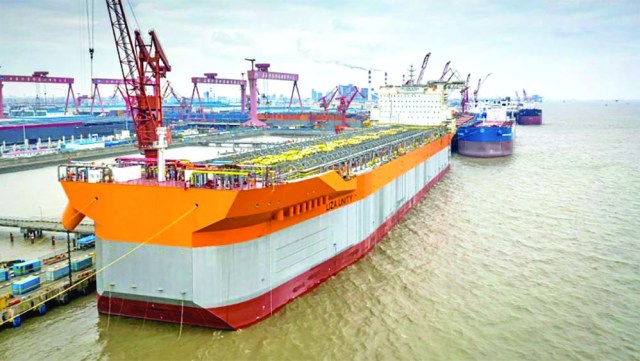– GNBS to begin testing Guyana’s crude oil this month
For many, a pressing question since Guyana received its first oil payment in 2020 has been when will Guyanese benefit directly from the oil revenue. Since it came to power in August 2020, the People’s Progressive Party (PPP) Government has steadily refused to touch the money until a transparent system for withdrawals was set up.

The recently passed Natural Resource Fund (NRF) Act has now set up such a system, allowing for the Government to make withdrawals from the Fund, overseen by Parliament and a Board of Directors, in order to finance urgent development needs for the country – including one early withdrawal in the first fiscal year of the Act.
This is according to Part IV, Section 17 (2) of the Act, which states that “In the first fiscal year that this Act comes into operation, notwithstanding the provisions of subsection (1) and of the first schedule, the ceiling on the amount that may be withdrawn shall be the total balance accumulated in the account described as “the Natural Resource Fund” as at the date that the Act comes into operation.”
Guyana ended the year 2021 with over US$600 million in the NRF, after a total of five oil lifts from the Liza Destiny Floating Production Storage and Offloading (FPSO) vessel for the year. This means that the year 2022, the first fiscal year with the Act in place, will see the Government being able to withdraw over US$600 million from the fund.
The Act is also clear on what the money can be spent on. Section 16 (2) states that “All withdrawals from the Fund shall be deposited into the Consolidated Fund and shall be used only to finance (a) national development priorities including any initiative aimed at realising an inclusive green economy and (b) essential projects that are directly related to ameliorating the effect of a major natural disaster.”
The Stabroek Block is 6.6 million acres (26,800 square kilometres). Exxon, through subsidiary Esso Exploration and Production Guyana Limited (EEPGL), is the operator and holds 45 per cent interest in the block. Hess Guyana Exploration Ltd holds 30 per cent interest, and CNOOC Petroleum Guyana Limited, a wholly-owned subsidiary of CNOOC Limited, holds the remaining 25 per cent interest.
GNBS
Guyana, with US oil giant ExxonMobil as the operator, began producing oil on December 20, 2019, in the Stabroek Block. It turns out that while oil exploration and production have been going on, the Guyana National Bureau of Standards (GNBS) has been quietly building its capacity to test the quality of Guyana’s crude.
In a press release, GNBS announced that from this month, it would begin testing crude oil produced in Guyana’s waters, while adhering to the American Petroleum Institute (API) Standards. This comes after the agency would have acquired additional equipment.
“Crude testing would be done to determine Density and Viscosity, Basic Sediments and Water, Salt in Crude, Hydrogen Sulphur in Crude, and Water Content. The GNBS with support from the Government of Guyana and other partners in Standardisation will continue to directly ensure that its measurement and testing services are provided onshore and offshore to protect the interest of the people of Guyana,” GNBS explained in its statement.
According to the Bureau, it has steadily built the capacity that allowed it to set up its Oil and Gas Department last year. And with the expected start of production on board the Liza Unity Floating Production Storage and Offloading (FPSO) vessel this year, the Bureau has hired six additional inspectors.
“Investments were made to train and build the competence of both its old and new Oil and Gas Inspectors for them to effectively and efficiently serve the sector. Inspectors were exposed to both practical and theoretical aspects of measurement and safety standards and principles,” GNBS said.
Oil revenue
Guyana’s oil revenues are being banked in the New York Federal Reserve Bank, where they are earning interest. In August 2021, Guyana received payment for its seventh oil lift to the tune of US$79,617,561.87. The Natural Resources Ministry has stated that this payment was for 1,047,820 barrels of oil, which was extracted from the Liza Destiny FPSO vessel on July 3, 2021.
The seventh oil lift brought the country’s oil extraction to a grand total of 7,056,262 barrels, and accumulative earnings to US$388,777,840. Guyana received its first payment of US$54.9 million for an oil lift dated February 19, 2020. The second lift, on May 21, 2020, was valued at US$35 million; while the third lift, which occurred on August 9, 2020, was worth US$46 million.
The fourth lift of oil offshore Guyana occurred on December 9, 2020, and came in at US$49.4 million in value. And on February 5, 2021, some 997,420 barrels of oil were lifted from Liza Destiny in the fifth lift. A sum of US$61 million was paid for that lift.
Guyana officially completed its fifth and final oil lift for 2021 (and eighth overall) in November, with a little over one million barrels of oil being lifted from the Liza Destiny FPSO vessel and sold by Saudi Aramco.
Discover more from Guyana Times
Subscribe to get the latest posts sent to your email.













